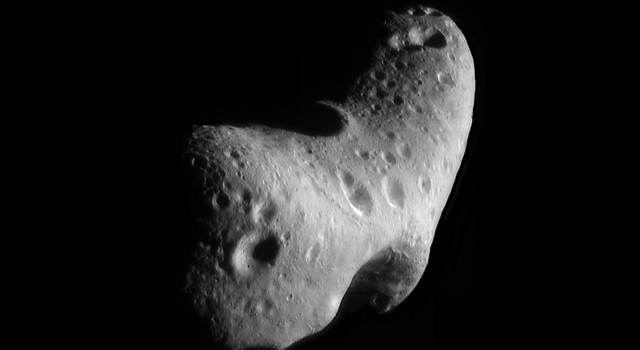Jun 19 2014
NASA will host a televised update on recent progress and upcoming milestones in the agency's efforts to identify, capture and relocate an asteroid, and send astronauts to take samples of it in the 2020s. The 10 to 11:30 a.m. PDT (1 to 2:30 p.m. EDT) event will kick off a two-day virtual workshop to highlight successes and new opportunities through NASA's Asteroid Grand Challenge, which coincides with its first anniversary.
 This image, taken by NASA's Near Earth Asteroid Rendezvous mission in 2000, shows a close-up view of Eros, an asteroid with an orbit that takes it somewhat close to Earth. NASA's Spitzer Space Telescope observed Eros and dozens of other near-Earth asteroids. Image Credit: NASA/JHUAPL
This image, taken by NASA's Near Earth Asteroid Rendezvous mission in 2000, shows a close-up view of Eros, an asteroid with an orbit that takes it somewhat close to Earth. NASA's Spitzer Space Telescope observed Eros and dozens of other near-Earth asteroids. Image Credit: NASA/JHUAPL
As leftover building blocks of the solar system, near-Earth asteroids may hold important clues about the origins of life and other scientific questions. Improving our understanding of asteroid composition and movement could help us protect Earth from impacts and identify good candidates for future missions as we expand human presence to Mars.
For these reasons and more, NASA is engaged in an Asteroid Redirect Mission, which plans to identify, capture and redirect an asteroid to a stable orbit around the moon, where astronauts will study it in the 2020s. New partnerships through the agency's grand challenge also are helping augment NASA's existing work to identify asteroid threats to Earth and figure out what to do about them.
During the event, speakers from multiple NASA centers and universities will discuss asteroid observation efforts and new findings, current and future testing for the Asteroid Redirect Mission, and ways for the public to participate in the grand challenge.
Participants in the update are:
- Lindley Johnson, program executive, NASA's Near Earth Object Program, Washington
- Michele Gates, program director, NASA's Asteroid Redirect Mission, Washington
- Jason Kessler, program executive, NASA's Asteroid Grand Challenge, Washington
- Paul Chodas, program scientist, NASA's Near Earth Object Program, Jet Propulsion Laboratory, Pasadena, California
- David Tholen, astronomer, University of Hawaii, Honolulu
- Marco Micheli, research assistant, University of Hawaii, Honolulu
- David Trilling, associate professor, Northern Arizona University, Flagstaff
- Michael Mommert, post-doctoral researcher, Northern Arizona University, Flagstaff
For more information on how to watch the event on NASA TV or online, visit: http://www.nasa.gov/nasatv
Questions can be submitted during the event on Twitter using the hashtag #AskNASA.
NASA's Asteroid Initiative comprises the Asteroid Redirect Mission and Asteroid Grand Challenge. Through the redirect mission, NASA will test new systems and capabilities needed to support future human missions to Mars. The grand challenge seeks the best ideas to find all asteroid threats to human populations and accelerate the work NASA already is doing for planetary defense.
For more information on the Asteroid Initiative and grand challenge virtual workshop, visit: http://www.nasa.gov/asteroidinitiative